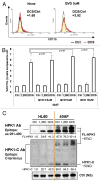Dual role of hematopoietic progenitor kinase 1 (HPK1) as a positive regulator of 1α,25-dihydroxyvitamin D-induced differentiation and cell cycle arrest of AML cells and as a mediator of vitamin D resistance
- PMID: 22421156
- PMCID: PMC3350877
- DOI: 10.4161/cc.19765
Dual role of hematopoietic progenitor kinase 1 (HPK1) as a positive regulator of 1α,25-dihydroxyvitamin D-induced differentiation and cell cycle arrest of AML cells and as a mediator of vitamin D resistance
Abstract
Recent clinical trials aimed at improved treatment of AML by administration of vitamin D derivatives showed unremarkable results, suggesting development of vitamin D resistance in patients' AML blasts. Since mechanisms of vitamin D resistance are not clear, we studied 40AF cells, a subline of HL60 cells that can proliferate in the presence of 1α,25-dihydroxyvitamin D₃ (1,25D). We found that mRNA and protein levels of HPK1, an upstream MAP4 kinase, are dramatically increased in 40AF cells, and HPK1 protein is further increased when the 1,25D resistance of 40AF cells is partially reversed by the addition of carnosic acid and p38MAPK inhibitor SB202190 (DCS cocktail). Knockdown of HPK1 reduces 1,25D/DCS-induced differentiation of both 1,25D-sensitive HL60 and U937 cells and 1,25D-resistant 40AF cells, but the effect of HPK1 knockdown on differentiation-associated G 1 arrest is more apparent in the resistant than the sensitive cells. To explain why 40AF and the intrinsically vitamin D-resistant KG-1a cells can proliferate in the presence of vitamin D, we found that the cleaved HPK1 fragment (HPK1-C) level is high in 40AF and KG-1a cells, but when differentiation is induced by DCS, HPK1-C decreases while full-length (FL)-HPK1 increases. Accordingly, inhibition of proteolysis with the pan-caspase inhibitor Q-VD-OPh reduced HPK1 cleavage and enhanced DCS-induced differentiation of 40AF cells. The results indicate that FL-HPK1 is a positive regulator of vitamin D-induced differentiation in AML cells, but the cleaved HPK1 fragment inhibits differentiation. Thus, high HPK1 cleavage activity contributes to vitamin D resistance, and HPK1 has a dual role in AML cell differentiation.
Figures






References
-
- Koeffler HP. Induction of differentiation of human acute myelogenous leukemia cells: therapeutic implications. Blood. 1983;62:709–721. - PubMed
-
- Huang ME, Ye YC, Chen SR, Chai JR, Lu JX, Zhoa L, et al. Use of all-trans retinoic acid in the treatment of acute promyelocytic leukemia. Blood. 1988;72:567–572. - PubMed
-
- Castaigne S, Chomienne C, Daniel MT, Ballerini P, Berger R, Fenaux P, et al. All-trans retinoic acid as a differentiation therapy for acute promyelocytic leukemia. I. Clinical results. Blood. 1990;76:1704–1709. - PubMed
Publication types
MeSH terms
Substances
Grants and funding
LinkOut - more resources
Full Text Sources
Other Literature Sources
Medical
